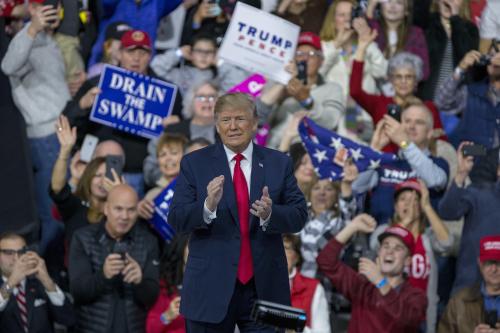Content from the Brookings Doha Center is now archived. In September 2021, after 14 years of impactful partnership, Brookings and the Brookings Doha Center announced that they were ending their affiliation. The Brookings Doha Center is now the Middle East Council on Global Affairs, a separate public policy institution based in Qatar.
Why and how do people vote? What motivates them? These are just some of the questions being asked ahead of Egypt’s upcoming elections, which will begin on November 28th. No one knows much about the voting habits of Egyptians. This, after all, is the first time in perhaps six decades they’ll be casting ballots in truly meaningful elections. In some sense, though, it isn’t rocket science. This is something that the Muslim Brotherhood — the country’s oldest and largest Islamist party — has long understood.
On November 16, I observed a Brotherhood “election march” in Ard al-Liwa, one of dozens occurring simultaneously across Egypt. The election march, or maseera, is deceptively simply but, at the same time, difficult for non-Islamist parties to replicate—one reason why no one else seems to be doing it.
The gathering point is almost always outside a mosque just after the evening prayer, which Brotherhood members are likely to be attending anyway. This guarantees the group a critical mass with relatively minimal effort.
In Ard al-Liwa, the streets are not ideal for cars, so many residents use a tuktuk, a sort of three-wheeled motorized cart to navigate the narrow alleys. The participants—numbering in the low hundreds—organized themselves into rows of three or four, often filling the width of street. Before the march began, they announced: “jihad is our path, Prophet Mohamed is our leader, and the Quran our constitution” (al-jihad sabeeluna, al rasool za’eemuna, w’al quran dusturuna)—a seemingly out-of-place relic in an otherwise modern, traditional campaign.
Two of the Brotherhood’s parliamentary candidates led the way. They walked up to residents—many of them storekeepers—quickly introduced themselves and shook hands. Behind them, the marchers were trailed by a pickup truck with a loudspeaker. If you happened to be in the area it was impossible to ignore. Everywhere, I noticed people coming out on their balconies to see what was happening.
After the candidates would shake hands with some onlooker, a volunteer would hand him a flyer and say a few quick words. Often, the volunteer engaged residents in conversation and, judging by their interest, wrote their names and phone numbers down on a piece of paper. As one volunteer told me, interested individuals can either join the Brotherhood’s political party—Freedom and Justice (FJP)—or participate in other activities organized by either the party or the Brotherhood itself.
The chants—focusing on freedom and justice—alternated between the predictable and the vaguely intriguing. The marchers were at pains to repeat at regular intervals that the party was founded by the Brotherhood (hizb assasuha al Ikhwan). There was no effort to paint Freedom and Justice as a distinct entity (although party and movement are technically administratively separate). One of the younger volunteers explained to me, “Some people still don’t know it’s the Brotherhood’s party, so this is something we always try to make clear.”
Ard al-Liwa is not an area known for its large Christian population, yet the Brothers chanted “Copts are sons of the umma [Islamic nation],” an interesting variation on the Brotherhood’s usual efforts to dispel sectarian fears. Other chants, meanwhile, were instructional, informing residents who was on the Brotherhood’s list and which candidates were running as individuals. (Egypt features a convoluted two-thirds, one-third mixed system of proportional representation and American-style single-member districts.) Each list or candidate has a symbol to help illiterate voters select candidates at the ballot box. This can also be confusing. Here, the list’s symbol was the scale of justice (mizan) while the two candidates shaking hands profusely were represented by a blender (khalat) and a gas oven (butagaz), respectively. The Brothers proved reliably creative in devising political rhymes for mizan and butagaz.
In the middle of the procession, organizers told the marchers to stop, telling them through the loudspeaker, “It is well-known that the Brotherhood is organized, so please go back to back to forming threes [in a row].” And then they began again.
The anatomy of a Brotherhood election march is easy to understand. Candidates meet residents and shake hundreds of hands. Volunteers pass out flyers and sign up supporters. But to do this on a national level and cover Egypt’s more than 40 million eligible voters requires thousands of organizers, tens of thousands of members and supporters, and considerable funding. Almost no parties—perhaps save the hardline Salafi ones—have these kinds of resources, and, for their part, many Salafis, after decades of shunning democratic elections as un-Islamic, are still uncomfortable with election marches. In Ard al-Liwa, the Brotherhood must have had around 30 designated “coordinators”—all volunteers—each of whom had a laminated FJP card hanging around their neck. So, when people ask why liberal and leftist parties don’t do something similar, it comes down, at least in part, numbers.
It is unclear how effective these marches are. If nothing else, they offer residents a show of strength—everybody likes a winner—and reinforce the Brotherhood’s street presence. The Brotherhood did this sort of thing for decades during Egypt’s long, dark period of consistently rigged elections. Sometimes the Brotherhood would still manage to win seats; sometimes they wouldn’t. But, in trying to win despite the odds, they were able to develop an organizational and electoral machinery few here could hope to challenge. Whether that machinery works as intended is something Egyptians—and everyone else watching Egypt’s landmark elections—are about to find out.



Commentary
Op-edHow Egypt’s Muslim Brotherhood Is Already Winning
November 18, 2011